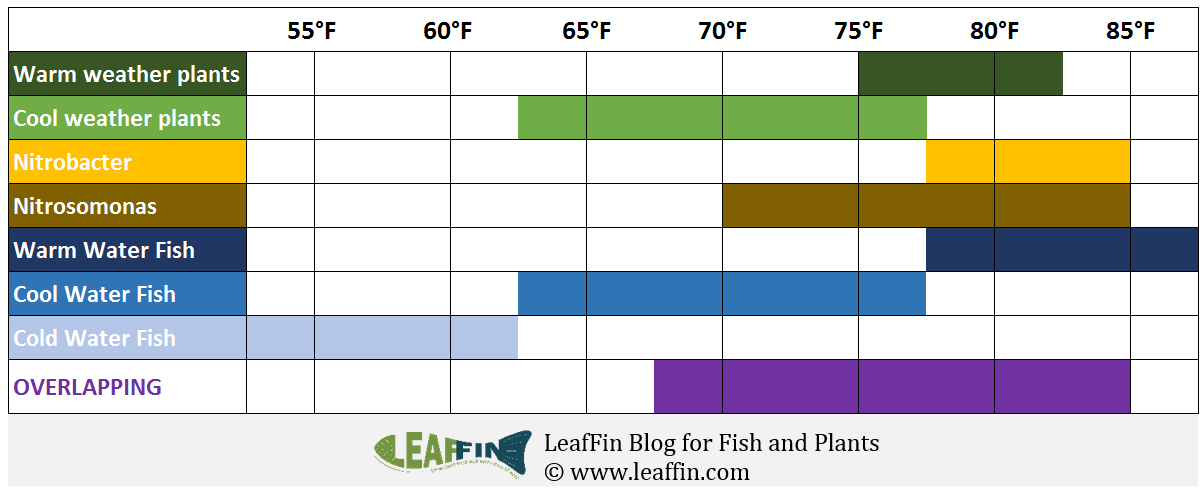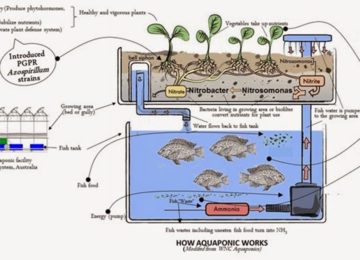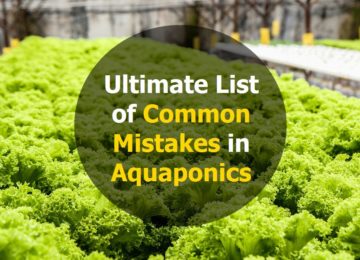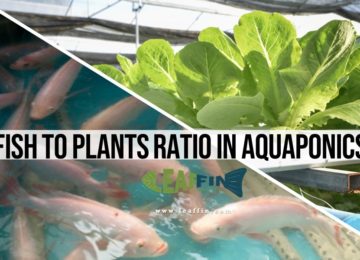Temperature is a key parameter in aquaponics. As you know, there are three main players in Aquaponics.
- Plants
- Fish
- Bacteria
Water temperature influences and affects all components and aspects of aquaponic systems. Overall, a general compromise range is 68-86 °F (20–30 °C). The temperature has an effect on the levels of DO as well as toxicity (ionization) of ammonia; The rise in temperature decreases the levels of DO and increases the unionized (toxic) ammonia.
Let’s have a look at how temperature effects!
Table of Contents
Temperature effect on Plants

The temperature range of 64-86 °F (18–30 °C) is ideal for most vegetables. However, a few vegetables are far more suited to growing in certain conditions.
Many cool season vegetables such as lettuce, Swiss chard, and cucumbers grow better in temperatures ranging from 8–20 °C. While warm weather vegetables such as okra, cabbages, and basil need temperature of 63-86 °F (17–30 °C). In temperatures higher than 79 °F (26 °C), leafy greens start to bolt and produce seeds and flowers, making them unmarketable and bitter.
So the first rule is to ensure that you are growing vegetables according to their season. Season and environment will also have an effect on the water of the aquaponics system. That can affect the plants’ ability to absorb nutrient and grow.
Your capacity to control the water temperature largely depends on where you’re growing the plants. It is more difficult to maintain the environment if you’re growing outside or in a hot/cold basement.
The ground naturally insulates the heat for the plants growing in soil.
If you dig a hole of over a foot deep, you will realize that how moist and cool it is down there compared to surface. The roots are comfortable and naturally live in that environment. Exposing the roots to conditions that are not comfortable to them put stress on the plant.
In aquaponics, the water temperature affects the plants more than the air temperature.
Problems resulting from High water temperatures
The rise in water temps will lead to heat stress in the plants. The plant shut the roots, ultimately going into survival mode when subjected to high water temperature.
Some symptoms of heat stress include
- wilting
- low levels of dissolved oxygen
- plants start to drop the flowers and abort fruiting
- roots start to get slimy
- soft and brown spots on fruits
- lettuce plants begin to bolt (elongate and go to seed)
- roots turn black and die
- restrict the ability to absorb calcium in plants.
The severity of the heat stress that plants are suffering is influenced by the air temperature and humidity too.
Problems resulting from cold water temps
Although the cold nutrient solution is mostly not a problem, it can create some issues when growing
- in a colder root cellar, basement, garage, etc.
- outside during winter, fall, and/or early spring
The low temps only have one significant disadvantage. The colder temperature stunts the plants’ growth. The severity depends on the duration of exposure and how cold the water temps are.
You may observe a reduced growth rate when the water temps drop below 60 °F (15 °C). Since air temperature largely influences the temperature of the water, reservoir temps are cold usually due to the cold season. The combination of cold air and reservoir temperature together cause a much-stunted growth rate. The plant still takes much longer time to start waking up due to the colder night temps, even during the daytime when the air around the water gets warmer.
Temperature and Fish
Fish being cold-blooded have less ability to adjust to a large range of water temperatures.
Furthermore, Fish can be categorized in cold water, cool water, and warm water fish. Generally, tropical fish (e.g. catfish, common carp, tilapia) thrive in higher water temperatures of 22–32 °C. However, cold-water fish such as trout prefer 10–18 °C. Whereas some temperate water fish have wider ranges, for example, largemouth bass and common carp can tolerate 5–30 °C. You need to consider many factors along with temperature to choose your fish, check this guide to choosing aquaponics fish.
A stable temperature within the right tolerance range
- Aids faster growth
- Keeps fish in their optimal conditions
- Facilitate and efficient Feed Conversion
- minimize the risk of diseases.
The fish appetite, particularly of tropical fish such as tilapia, also directly relates to the water temperature. So make sure to alter and reduce the feeding during the winter season.
The rise in temperature enhances the rate of respiration and metabolism as well as oxygen requirement of fish, approx doubling the respiration for a 10° C rise in temperature. Hence it can be said that the oxygen demand rise under the conditions of lower oxygen supply. The rise in temperature increase as well as intensify the solubility of many toxic substances.
Dissolved oxygen is largely influenced by pH, Temperature and water quality. See in details Role of Dissolved Oxygen in Aquaponics
You can use thermal isolation, water heaters, and chillers to achieve desired temperature level, although this may increase the operational cost in areas where energy is expensive. It is always better to keep fish that adapts to local environmental conditions. You should research the optimum temperature range of each fish that you have shortlisted for your system.
Check the best water heaters for Aquaponics here
Nitrifying Bacteria
Water temperature is a vital component for bacteria, and for aquaponics in general. The optimal temperature range for bacteria productivity and growth is 17–34 °C. The growth rate will decrease by 50% at 64° F (18° C) and by 75% at 46-50° F. No activity occur at 39° F (4° C). The temperature levels lower than 32° F (0° C) or higher than 120° F (49° C) kills Nitrifying bacteria. The low-temperature levels have a signifant influence on system management during winter.
Aquaponics cycle depends largely on these bacteria. Also, read What are the Water Parameters that affect Aquaponics Cycle
Overlapping Temperature
The optimal temperature for aquaponics is
Fish Temperature = 10-32 °C
Root zone temperature = around 22 °C
Bacteria and Nitrification = 25-30 °C

The general temperature range is 20-30 °C that should be adjusted according to the fish or plant species. The bacteria thrive throughout this temperature range. It is important to pick a suitable combination of plant and fish species that match well with each other and the environmental conditions.
If the temperature is too high
- Some fish will eat more food and hence ammonia/nutrients will increase
- Higher temperatures diminish the solubility of dissolved oxygen and thus decrease the availability of this essential gas.
- Plants will begin to wilt and die.
If the temperature is too low:
- Bacteria will stop working
- Some fish may not eat
- Slower Plants growth
Recommendations
- Carefully choose the right types of fish and plants to fulfill their optimal water temperature needs.
- Choose the plants and fish already adapted to the local climate. However, there are management techniques that can minimize temperature fluctuations and extend the growing season.
- Shield the water surface itself, in all of the water tanks and units, from the sun using shade structures. Since systems are more productive if the daily, day to night, temperature fluctuations are minimal.
- Similarly, you can protect the unit thermally by using insulation against cold temperature in night. Alternatively, you can use greenhouses or solar pannel with coiled agricultural pipes to passively heat the aquaponic units, practically ideal for the temperature lower than 15 °C;
- Take into consideration the seasons of vegetable while choosing the fish




Hi! This may be a silly question, but what are you referring to when you when you mention “DO”?
Dissolved Oxygen
You can read more here
https://www.leaffin.com/dissolved-oxygen-aquaponics/
What is the optimal temperature (°C) for Lettuce, Spinach and Basil in AP?
And what is the life span and planting spacing of the above mentioned Crops in AP?
I have 2 circular tanks, 8 m diameter in an enclosed plastic covered house with tilapia.
Do i have to fully enclose the side structures of the house to avoid cold temperatures in the early mornings which causes mortalities to the fry at 15 days old?